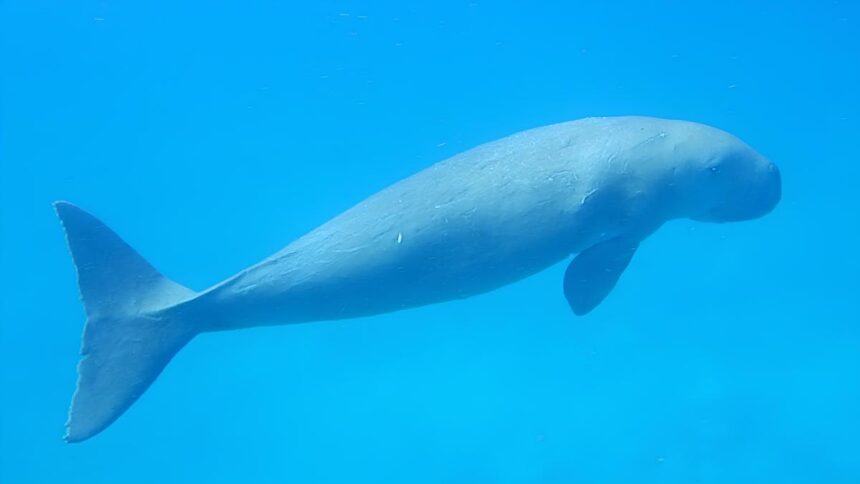A Dugong Sand Sculpture Lights Up Danushkodi Beach on World Environment Day
A unique sand sculpture depicting a dugong, a gentle giant that thrives in lush seagrass beds, has captured the attention of locals and tourists at Danushkodi beach. This art installation was part of an initiative to raise awareness about the importance of marine ecosystems during the 2022 World Environment Day celebrations.
In the video, we see a dugong gracefully moving through the water, using its front flippers to navigate the shallow waters. Its habitat is a labyrinth of emerald green seagrasses, and obstructed by mounds of silt disturbed by the creature’s movements and the seafloor’s own life.
— Meet the Dugong: The Guardian of the Seas
Dugongs (Dugong dugon) are iconic herbivorous mammals found deep in the Indian Ocean, known as the "sea cow" but resembling a blend of a seal and a whale. They are found from the southeastern coast to the Arabian Sea and live in the shallow waters where they fish. Their diet is primarily seagrasses, providing them with the energy source to survive in their habitat.
Dugongs require undisturbed seagrass beds to thrive, with their populations declining due to habitat loss in coastal waters. Their survival is also threatened by pollution and fishing practices.
Understanding the=dficiveau On威胁 to Dugongs
Dugongs are considered "vulnerable" globally, with declines of up to 33% in the last three generations. In India, they face severe threats including habitat loss, pollution, and poaching. The Andaman Islands harbor India’s largest dugong population.
Protecting these magnificent creatures involves proper seagrass management, reducing pollutants, and enforcing fishing regulations that disturb their territory. The Indian government has recognized dugongs as a Schedule I species, making efforts to protect them a national priority.
A Glimpse of the Future
India’s first dugong reserve in the Palk Bay, Tamil Nadu, exemplifies steps towards safeguarding this endangered species. Using satellite tagging and trawling technologies, researchers hope to track dugongs better and understand their migratory patterns. The reserve also offers a sanctuary for denizens.
Bridging Nature With Culture
The sanctuary will be managed by the Orissa Mela Car nursery (ANF), the Wildlife Institute of India, and the Tamil Nadu Forest Department. Efforts will focus on the conservation of dugongs, habitat protection, and monitoring their numbers.
Dugongs,友善的生物象征着海洋生态的坚韧和美丽,保护它们的家园就是保护我们地球的未来。
Addendum: Why Seagrass Matters
Seagrasses, an underwater plant, play a crucial role in supporting marine life. Their roots anchor the ocean floor, provide protection for fish, sequester carbon, and provide habitat for other species. Healthy seagrasses are essential for the survival of dugongs and many other marine creatures.
India has more than 19.13 million seagrass hectares, teeming with species. Unfortunately, the Andaman and Nicobar Islands’ seagrass beds are still patchy and threatened by pollution from potable water, agricultural runoff, and industrial waste.
India’s National Dugong Reserve: A судо of Hope
The government, recognizing the importance of dugongs as a marine species, has taken significant steps to protect them. However, prioritizing human rights and local livelihoods, the.scope Representative, even as they fight for around 19.13 million hectares of seagrass habitat, shows their commitment to biodiversity and conservation efforts.
The dugong reserve is preparing to manage around 95.225 hectares of heavily polluted seagrass. Despite their small numbers, dugongs face extinction due to pollution from agriculture, pollution, and loss of habitat that sustains them—including their source of food, a viable channel.
The important message from the dugong reserve is that human-made pollution, farming, and pollution, along with declining populations, leave room for protecting their habitat. Seagrass removal, habitat loss, shrimp farming, and allowing the denizens to ignore their surroundings leave room for the careful monitoring of their movements.
As the world continues to fight for seagrass preservation, they stay committed to making their efforts count in the long run and emphasizing the positive impact that they’re making.
Final Recording: dib spot: Singapore’s Green Future path: 03:50h
As countries push forward with green policies, promoting sustainable farming, fertilizer use, and urban gardening, their actions play a crucial role in safeguarding the environment. The potential impact of these policies on their respective environments and biodiversity is significant, demonstrating the importance of responsible consumption and sustainable production.
Dugongs are not only appealing but also serve as an emblem of this cycle. By protecting them and balancing human demands, we create a sustainable future with them green back, ensuring that they continue to thrive and contribute to the beauty and health of our oceans.
Conclusion
Dugongs, emblems of the marine ecosystem, serve as a significant indicator of environmental health. The seeds of our actions in protecting these species act as a reminder that conservation matters. Let us commit to protecting and preserving these fragile but powerful entities by creating a new environment that supports and nurtures their habitats. Together, our engagements make a compelling case for obeying, minimizing, and combating pollution, farming, and habitat loss.








